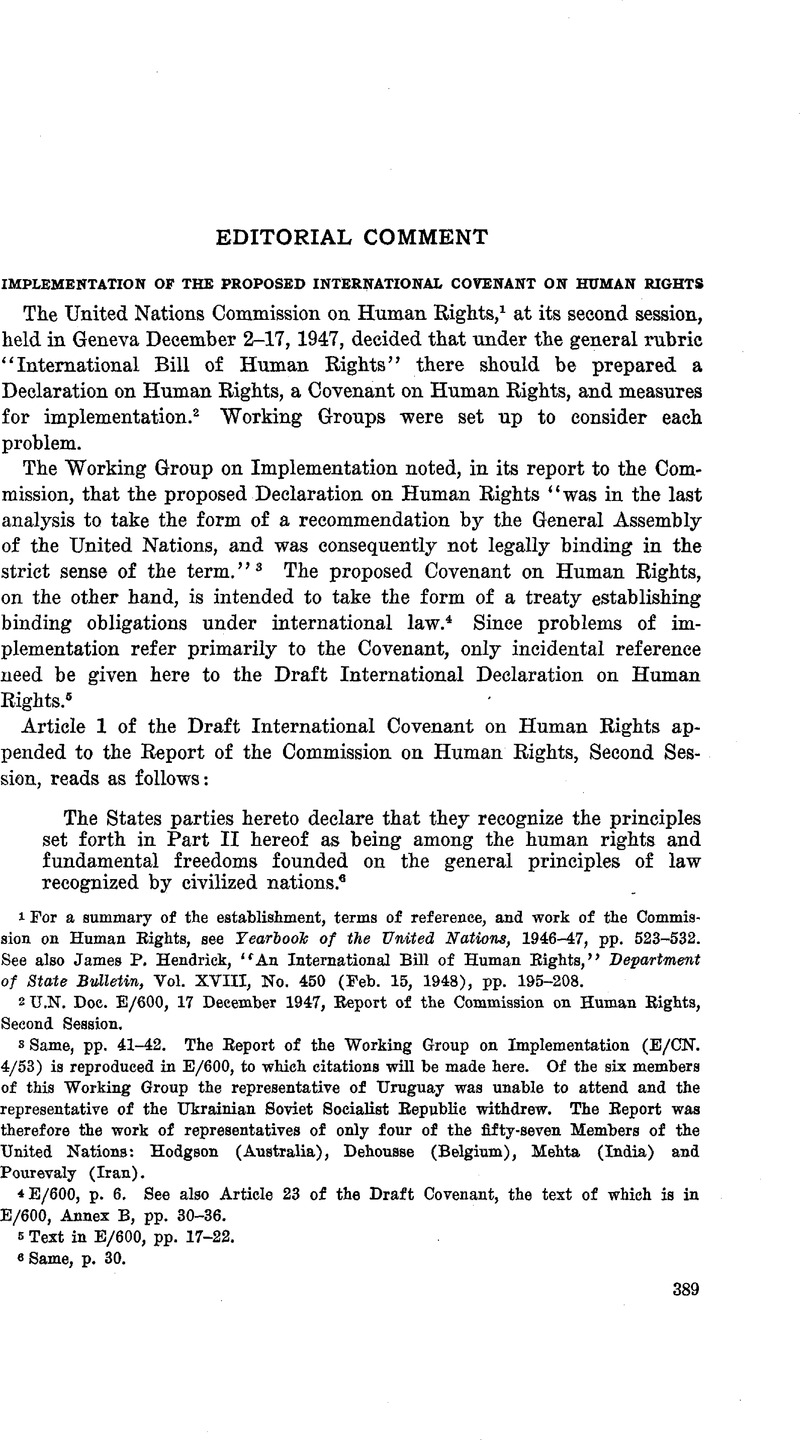Published online by Cambridge University Press: 20 April 2017

1 For a summary of the establishment, terms of reference, and work of the Commission on Human Eights, see Yearbook of the United Nations, 1946–47, pp. 523–532. See also Hendrick, James P. “An International Bill of Human Rights,” Department of State Bulletin, Vol. XVIII, No. 450 (Feb, 15, 1948), pp. 195–208.Google Scholar
2 U.N. Doc. E/600, 17 December 1947, Report of the Commission on Human Rights, Second Session.
3 Same, pp. 41–42. The Report of the Working Group on Implementation (E/CN. 4/53) is reproduced in E/600, to which citations will be made here. Of the six members of this Working Group the representative of Uruguay was unable to attend and the representative of the Ukrainian Soviet Socialist Republic withdrew. The Eeport was therefore the work of representatives of only four of the fifty-seven Members of the United Nations: Hodgson (Australia), Dehousse (Belgium), Mehta (India) and Pourevaly (Iran).
4 E/600, p. 6. See also Article 23 of the Draft Covenant, the text of which is in E/600, Annex B, pp. 30–36.
5 Text in E/600, pp. 17–22.
6 Same, p. 30.
7 See Comment in United Kingdom proposal on International Bill of Human Rights, annexed to Report of the Drafting Committee to the Commission on Human Rights, E/CN.4/21, 1 July 1947, p. 30. The British draft was apparently the basis for the Commission draft.
8 E/CN.4/37, 26 November 1947, p. 1.
9 See E/600, pp. 42–43; E/CN.4/AC.4/SK/1–3.
10 See Report of the Drafting Committee, Annex H, Memorandum on Implementation prepared by the Secretariat, E/CN.4/21, pp. 87–97.
11 E/600 , p. 43.
12 E/600 , p. 43.
13 United States, Foreign Relations, Paris Peace Conference, 1919, Vol. XIII , pp. 791,798, 801.
14 Compare Article 18 of Professor Lauterpaeht’s draft: “This International Bill of Rights of Man is hereby declared to be an integral part of the Law of Nations. It is placed under the guarantee of the United Nations. . . . Its observance shall be a matter of concern to all the United Nations.” H. Lauterpacht, An International Bill of the Rights of Man, 1945, p . 73, with comment, pp. 194 ff.
15 E/600, pp. 44–46. Italics in original. Compare Article 15 of Professor Lauterpaeht’s draft: “Every State shall, by appropriate constitutional means, adopt Part I of this International Bill of Bights of Man as part of its domestic law and constitution. The effect of such adoption shall be to abrogate any existing statute or any other rule of law inconsistent with these Articles. . . . They shall not be abrogated or modified by legislative action or otherwise, save in pursuance of international agreement or authorization.” Lauterpacht, cited, pp. 72, 179 ff.
16 E/600, p. 46.
17 E/600, pp. 44, 46.
18 See also E/CN.4/AC.4/1, Letter from the Kepresentative of France to the . . . Working Party on Implementation . . . , 5 December 1947.
19 E/CN.4/21, p. 88.
20 E/600, pp. 47–49.
21 Same, pp. 49–51.
22 Same, pp. 51–53.
23 Same, pp. 53–56.
24 Same, p . 56
25 Same, pp. 58–62.
26 Same, p. 63.
27 Query whether it is intended that the proposed court give judgment only against Jr States, or whether employers or other individuals might be adjudged violators of human rights.
Compare Article 5 of the United States Proposal for a Human Rights Convention E/CN.4/37):
28 E/600, p. 7.
29 Same, p. 67.
30 E/CN.4/AC.4/SR.7.
31 See Part II of the Draft International Covenant on Human Rights, E/600, pp. 31–35.
32 82E/CN.4/56, 11 December 1947, Report of the Working Party on an International Convention on Human Rights.